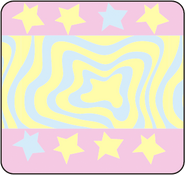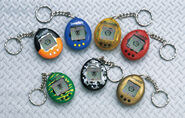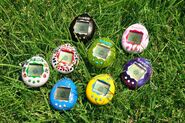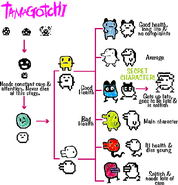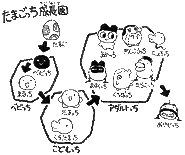(→Legacy) Tag: Visual edit |
No edit summary |
||
| Line 36: | Line 36: | ||
===Concept and Creation=== |
===Concept and Creation=== |
||
| + | [[File:Tamagotchi_Prototypes.jpg|left|thumb|150px|Concept artwork and prototype units.]] |
||
| + | |||
The toy's concept was developed by [[Akihiro Yokoi]] of Bandai. He came up with the idea after seeing a commercial about a boy attempting to bring his pet turtle on a trip. He initially proposed the idea to Bandai in 1995 but was rejected, leading him to do market research. Gathering information from Tokyo’s Shibuya district, he concluded that most handheld electronic games were targeted towards young boys, and in order to market successfully to young women, the device would have to be "''{{wp|kawaii}}''". |
The toy's concept was developed by [[Akihiro Yokoi]] of Bandai. He came up with the idea after seeing a commercial about a boy attempting to bring his pet turtle on a trip. He initially proposed the idea to Bandai in 1995 but was rejected, leading him to do market research. Gathering information from Tokyo’s Shibuya district, he concluded that most handheld electronic games were targeted towards young boys, and in order to market successfully to young women, the device would have to be "''{{wp|kawaii}}''". |
||
| Line 55: | Line 57: | ||
On September 9th, 2020, Tamagotchi was announced as one of twelve finalists with a chance of being inducted into the {{wp|National Toy Hall of Fame}}<ref>https://www.museumofplay.org/press/releases/2020/09/6154-national-toy-hall-of-fame-reveals-2020-toy-finalists</ref>. A red and black US generation 1 shell in its original packaging was selected, with the brand being described as "Inspiring strong attachment and fascination, the Tamagotchi became a personal electronic device that playfully absorbed our attentions and extended our cultural fascination with robots and androids." |
On September 9th, 2020, Tamagotchi was announced as one of twelve finalists with a chance of being inducted into the {{wp|National Toy Hall of Fame}}<ref>https://www.museumofplay.org/press/releases/2020/09/6154-national-toy-hall-of-fame-reveals-2020-toy-finalists</ref>. A red and black US generation 1 shell in its original packaging was selected, with the brand being described as "Inspiring strong attachment and fascination, the Tamagotchi became a personal electronic device that playfully absorbed our attentions and extended our cultural fascination with robots and androids." |
||
| + | |||
| + | ==Backstory== |
||
| + | [[File:BanzoMikachuUFO.png|left|thumb|150px|Banzo and Mikachu holding a damaged UFO.]] |
||
| + | |||
| + | The Tamagotchi are a race of aliens from the far distant [[Tamagotchi Planet]], described as being "millions of miles" from [[The Earth]]. The Tamagotchis lived peacefully on their planet until one fateful day, when a disgruntled [[Oyajitchi]] made the Planet drink his bottle of sake, causing it to become drunk. With the Planet uninhabitable, the Tamagotchis fled aboard [[UFO]]s to find another planet to live on while waiting for their home to sober up. |
||
| + | |||
| + | One night, [[Professor Banzo]], owner of the [[Strange Biology Institute]], was sulking on a bridge over {{wp|Sumida River}} after suffering a broken heart. Suddenly, a UFO from space collided with him and knocked him into the river. He brought the UFO to his lab where he and his assistant [[Mikachu]] tended to the aliens inside. In order to allow the aliens to live on Earth safely, Banzo constructed the "Tamagotchi House" (''たまごっちHOUSE''), an egg-shaped device that allowed the Tamagotchi to be cared for with a screen and simple controls. |
||
| + | |||
| + | Mikachu began painting the shells of the devices different colors and brought them to school with her, gaining the attention of her classmates. As more species of Tamagotchi were discovered, Banzo sent more of the devices to research facilities in other parts of Japan, and eventually across the world. |
||
| + | |||
| + | The events are told on the [[Tamagotch Channel|official site]], both volumes of the [[Tamagotchi Research Report: Tamagotchi Book]], and [[Tamagotchi Honto no Hanashi]]. The North American book [[Tamagotchi: The Official Care Guide and Record Book]] alludes to the story but leaves out the Planet becoming drunk, instead saying the Tamagotchi had come to study what life is like on Earth. |
||
==Design== |
==Design== |
||
Revision as of 12:12, 20 September 2020
| None | Tamagotchi (1996 Pet) | Mothra Tamagotchi → |
|---|---|---|
| This article is about a Japanese Tamagotchi release. | ||
| None | Tamagotchi (1996 Pet) | Tamagotchi Angel → |
|---|---|---|
| This article is about an English Tamagotchi release. | ||
The original Tamagotchi (たまごっち) was the first Tamagotchi toy produced. It was released in Japan on November 23, 1996 by Bandai. A second version, also known as the New Species Discovered!! Tamagotchi (新種発見!!たまごっち Shinshu Hakken!! Tamagotchi) in Japan, was produced not long after featuring new characters and a new game. The two versions are differentiated officially as "Generation 1" and "Generation 2", and are colloquially referred to as the "P1" and "P2" respectively by fans.
The original Tamagotchi introduced and codified many of the core features still used on almost all Tamagotchi virtual pets to this day. It was also ported to two mobile applications, Tamagotchi L.i.f.e. and Tamagotchi Classic, both of which are now discontinued.
History
Concept and Creation
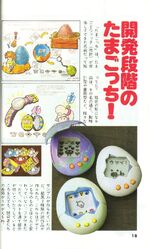
Concept artwork and prototype units.
The toy's concept was developed by Akihiro Yokoi of Bandai. He came up with the idea after seeing a commercial about a boy attempting to bring his pet turtle on a trip. He initially proposed the idea to Bandai in 1995 but was rejected, leading him to do market research. Gathering information from Tokyo’s Shibuya district, he concluded that most handheld electronic games were targeted towards young boys, and in order to market successfully to young women, the device would have to be "kawaii".
He worked closely with Aki Maita during the development, although only Maita would be publicly credited as the creator of Tamagotchi for several months. The original pitch imagined the Tamagotchi to worn as a wristwatch, but was later reimagined into a keychain to emulate a pocket watch. Character design was originally done by Yōko Kuroyanagi, but after she was fired, Kenji Watanabe took over. The international style and characters were developed by Bob Nenninger.
In October 1996, 200 prototype units were given out to high school girls in Tokyo's Shibuya district for a consumer test. The girls were surveyed about the toy over several weeks, and the final toy was launched on November 23, 1996. The toys came to the United States the following May.
Rerelease
In November 2017, Bandai Japan announced that they would be re-releasing exact replicas of both the original generation 1 and 2 Tamagotchis on November 23rd, 2017 as a final send off to the franchise's 20th year, alongside the 20th Anniversary Tamagotchi Mini and the Tamagotchi m!x Gift version.
While the new Mini was released internationally about half a year after its Japanese release, GameStop's inventory announced in early summer 2018 that the originals would be released in the US in August 2018, but later pages on their website instead stated an October 2018 release. In early July 2018, Bandai announced that exclusive metallic generation 1 and 2 Tamagotchi toys would be available in limited amounts from their booth at that year's San Diego Comic-Con. The replicas were made available to the public on September 30th of that year.
Legacy
Akihiro and Aki were jointly awarded an Ig Nobel Prize, credited as "the father and mother of Tamagotchi" for "diverting millions of person-hours of work into the husbandry of virtual pets"[1]. As Tamagotchi was garnering a sizable female audience, the duo would later create Digimon using the same groundwork and overall concept as Tamagotchi, but with a more masculine style and added training and battling in an attempt to increase virtual pet appeal to males. The Tamagotchi effect, how humans develop emotional attachments and reactions to artificial life, was named after Tamagotchi.
Tamagotchi is often credited as the world's first handheld virtual pet, and has sparked a successful franchise, adaptations to other mediums, and several imitators, such as Nano Pets from PlayMates Toys and Giga Pets from Hasbro (originally from Tiger Electronics).
A 1997 Hong Kong Collector's Edition generation 1 model is set to be included in the upcoming M+ museum in Hong Kong, scheduled to open in 2021[2].
On September 9th, 2020, Tamagotchi was announced as one of twelve finalists with a chance of being inducted into the National Toy Hall of Fame[3]. A red and black US generation 1 shell in its original packaging was selected, with the brand being described as "Inspiring strong attachment and fascination, the Tamagotchi became a personal electronic device that playfully absorbed our attentions and extended our cultural fascination with robots and androids."
Backstory

Banzo and Mikachu holding a damaged UFO.
The Tamagotchi are a race of aliens from the far distant Tamagotchi Planet, described as being "millions of miles" from The Earth. The Tamagotchis lived peacefully on their planet until one fateful day, when a disgruntled Oyajitchi made the Planet drink his bottle of sake, causing it to become drunk. With the Planet uninhabitable, the Tamagotchis fled aboard UFOs to find another planet to live on while waiting for their home to sober up.
One night, Professor Banzo, owner of the Strange Biology Institute, was sulking on a bridge over Sumida River after suffering a broken heart. Suddenly, a UFO from space collided with him and knocked him into the river. He brought the UFO to his lab where he and his assistant Mikachu tended to the aliens inside. In order to allow the aliens to live on Earth safely, Banzo constructed the "Tamagotchi House" (たまごっちHOUSE), an egg-shaped device that allowed the Tamagotchi to be cared for with a screen and simple controls.
Mikachu began painting the shells of the devices different colors and brought them to school with her, gaining the attention of her classmates. As more species of Tamagotchi were discovered, Banzo sent more of the devices to research facilities in other parts of Japan, and eventually across the world.
The events are told on the official site, both volumes of the Tamagotchi Research Report: Tamagotchi Book, and Tamagotchi Honto no Hanashi. The North American book Tamagotchi: The Official Care Guide and Record Book alludes to the story but leaves out the Planet becoming drunk, instead saying the Tamagotchi had come to study what life is like on Earth.
Design
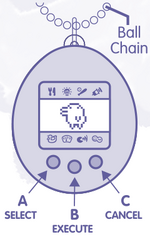
Diagram of a standard Tamagotchi.
The classic Tamagotchi is 5 centimeters tall, or about 2 inches tall, with a small LCD on the front and three buttons. The displayed LCD is 32 pixels wide by 16 inches tall, with two rows of icons above and below. Behind the screen is a printed cardboard sheet for the background, and around the screen is a "cracked eggshell" pattern. On top of the Tamagotchi is a hole for a keychain, which is typically a ball and chain, though for English releases may sometimes be a chain and ring.
The left button ("A") moves the icon selection on the screen, starting from the top left, moving right, and then to the bottom row. The middle button ("B") confirms the use of a selected icon, or switches to the clock screen if no icon is selected. The right button ("C") will clear any icon selection, and close whatever menu the screen is currently showing. The back of the unit has a fourth "Reset" button, smaller than the front buttons and recessed within the battery compartment, and can only be pressed by a small, thin object (such as a pen or pencil). Pressing this button at any time will clear the current Tamagotchi, bringing it back to the Egg stage, and reset the clock.
The battery compartment is different between the original and rerelease versions; the original is smaller and has two screws, while the rerelease is larger and has one screw, as well as a lip to hold the battery in place. Original English and Japanese versions have a battery warning sticker, while the rerelease has waste disposal warnings molded into the battery compartment. The right side of the unit has a thin slot, where an insulation tab is inserted, blocking the battery from the contacts. The tab must be pulled out before the Tamagotchi can be used.
The background print indicates which generation the unit is running. Generation 1 units have a blue and pink checkerboard background, with the icon rows being yellow with pink splats and blue hearts. Generation 2 units have a yellow and blue ripple pattern background, with the icon rows being pink with yellow and blue stars.
With the exceptions of the Tamagotchi Angel, Tamagotchi Osutchi and Mesutchi, Debirutch no Tamagotch, Yasashii Tamagotch, and Doraemontchi, all vintage-era Tamagotchi releases use nearly-identical molding, but with the battery panel changed to indicate the year of manufacture. In addition, some models also have indents around the buttons. Almost all units were made in China, while some European models were made in Indonesia and Taiwan.
Features
The Original Tamagotchi contains most of the features that are still used in modern-day Tamagotchi toys and games.
Growth and Lifespan
The Tamagotchi will go through several stages of life once it has been born. It begins with the Baby stage and evolves to the Child stage after 65 minutes. It will evolve into a teen at the age of 3, and into an adult by the age of 6. What Teenager and Adult stage it will evolve into are based on the quality of care the user has given the Tamagotchi throughout its life. Each version of the classic Tamagotchi has one Baby character, one Child character, two Teenager characters, six Adult characters, and one Special character that evolves from one of the six Adults.
A Tamagotchi will eventually die of old age, and the maximum lifespan varies from character to character. As a Tamagotchi grows older, they will begin to lose hearts faster and faster - on the original releases, the heart loss rate caps at 1 Hungry heart every 7 minutes, and 1 Happy heart every 9 minutes. On the 2017 rereleases, the heart loss rate caps at about 1 of each at every 16 minutes.
Clock
The user must set the time before the Tamagotchi can hatch. Pressing the B button when no icon is highlighted will bring up the clock screen and holding A and C will allow them to adjust the time - doing the latter is not necessary from a fresh start. A adds hours, B adds minutes and C confirmed the new time, and pressing B again will return to the normal screen. The Tamagotchi will not age, lose hearts, poop etc. as long as the clock is in adjustment mode, thereby allowing it to be used as a "Pause" mode.
Feed

The user uses this icon to feed their Tamagotchi either a meal or snack. Meals fill the Hungry hearts, and each meal adds 1 to the Tamagotchi's weight. Snacks raise one Happy heart and add 2 to the Tamagotchi's weight. Feeding a Tamagotchi too many snacks within a short period of time will make it sick, and continuously doing so will kill it - on the 20th anniversary rereleases, even spacing out a significant number of snacks across its life will likely cause a Tamagotchi to die prematurely. Overfeeding a Tamagotchi snacks is the only way it can die during the baby stage - this is not possible on the rereleases.
The meal is a bowl of rice on the Japanese edition, and a slice of bread on the International editions. The snack in all regions is a piece of candy in a wrapper.
For the second generation, the meal is an onigiri in Japan, and a hamburger for English editions. The snack on all versions is a slice of cake. On the English release, the food options are shown as pictures rather than words.
Light

When the Tamagotchi goes to sleep, the user selects this icon to turn the lights on or off. Not turning the lights off before the Attention icon vanishes will result in a care mistake. A Tamagotchi will only grow and age while it is awake, and a year will be added to its age on the check meter every time it wakes up. Every Tamagotchi has its own waking and sleeping hours. Turning off the lights while the Tamagotchi is awake will not impact its health, but will make it impossible for the user to see if the Tamagotchi has made a poo or gotten sick.
Game

This icon allows the user to play a game with their Tamagotchi to raise its happiness and lower its weight. Playing a complete game will always reduce the Tamagotchi's weight by 1. Each game lasts five rounds, and if the user wins a minimum of three rounds, the game is won and the Tamagotchi fills one Happy heart. Once five rounds are played, it will show a results screen showing how well the game was played. If the user presses A or B after the results screen, a new game will start. If the Tamagotchi poops, gets sick, calls for attention, or falls asleep while in the process of playing the game, the game will not resume after the results screen.
Left or Right
The game featured on the original Tamagotchi is "Left or Right". The user must guess whether their Tamagotchi turns left or right. The A button chooses left, while the B button chooses right. The C button returns to the main screen. When playing with certain adults, there may be a several second delay between the press of the button and the Tamagotchi turning.
Higher or Lower
The game featured on the second generation Tamagotchi is "Higher or Lower". The Tamagotchi presents a number, and the player must guess whether the next number it thinks of will be higher (B button) or lower (A button) than the displayed number. It cannot pick a number higher than 9, or lower than 1. On the original release, the number the Tamagotchi starts with in its lifespan is 5, and the second number it chooses will be the initial number of the next round and subsequent games. On the 20th anniversary rerelease, the Tamagotchi may start every round with a new number rather than the second one it thought of from the previous round.
Medicine


When the Tamagotchi becomes ill, a skull will appear on the top right corner of the Tamagotchi, and they will refuse to eat or play. Using the Medicine icon will heal them. It may take one or two doses to cure the sickness. The Tamagotchi will get ill prior to evolution, before death, with old age, if poo has been left on the screen for too long, or if fed too many snacks. Every time the Tamagotchi gets sick from old age, its stats will begin to decrease at a faster pace.
The icon is a syringe on all Japanese versions, and on all English generation 1 models. For English generation 2 models in 1997, it is a bottle of medicine with a spoon. On the 2017 rereleases, the icon is a syringe on all versions in all regions.
Bathroom

Throughout its life, the Tamagotchi will leave poo on the screen. The user must select this icon to clear it away. Leaving poo on the screen for too long may result in illness, while multiple poop on the screen drastically increase the likelihood of illness. The baby will poo twice (15 and 40-45 minutes after hatching) before it evolves. Once at the child stage, it will leave poo after five minutes, and then one poo every three hours.
Meter

The Tamagotchi features a Check meter screen that shows the Tamagotchi's overall stats. The first screen displays age (one year being the equivalent of one day) and weight (measured in grams on the Japanese versions, ounces on international P1s, and pounds on international P2s), the second displays Discipline, the third shows Hungry, and the fourth shows Happy. There are a total of four hearts each for hunger and happiness, with white hearts representing an empty stat. The rate at which hearts decrease depends on the kind of Tamagotchi, and also how old they are in regards to adults.
Discipline

The Discipline icon is used to scold the Tamagotchi for misbehavior. Occasionally, the Tamagotchi will call for attention when its Hungry and Happy meters are not completely empty, and refuse to eat or play games. When this occurs, the user must use the Discipline icon. When used correctly, a special sound effect will play and the attention icon will turn off. Using the icon when the Tamagotchi is not misbehaving will cause it to lose a Happy heart.
The amount of discipline the Tamagotchi receives directly affects what they grow up into. Each successful punishment adds 25% to the discipline meter, but the discipline level may be reduced by evolution. On the original release, during each growth stage, the Tamagotchi will only make enough calls to completely fill the meter from however full it presently is (for example, a teen that began with 50% discipline will call twice). On the 2017 rereleases, a Tamagotchi may make more calls than necessary, given the user the opportunity to fill the meter even if some calls were missed.
If the Tamagotchi evolves within fifteen minutes of a discipline call, the user will still have a chance to discipline them until the attention icon turns off as usual.
Attention

This icon cannot be selected and lights up on its own when the Tamagotchi needs something - hunger or happiness being completely empty, falling asleep and requiring the lights to be turned off, or making a false call and requiring discipline. If the user does not tend to their needs within 15 minutes, the icon will turn off and a care mistake will occur (unless the Tamagotchi was making a discipline call). If a Tamagotchi dies from neglect while the attention icon is on, it will remain lit on the death screen until a new egg appears. The Tamagotchi will not call for attention when it poops, nor if it gets ill.
Death
A Tamagotchi will eventually die due to either neglect or old age, with the oldest possible Tamagotchi living to 25 years, or about 24 real-world days. The death screen varies by region: the Japanese models show a ghost floating around a gravestone, the English P1 shows an angel flying among stars, and the English P2 shows a UFO in space. If the user maintained good care during the adult stage, it will show an additional animation of the Tamagotchi laying an egg just before it passes. These eggs don't hatch into anything and disappear after the death sequence ends. Child and teen characters will never lay eggs upon death. If a baby dies, it skips the death sequence entirely, with the screen fading away similar to the evolution screen before showing the death screen.
Pressing the C button will scroll the screen to the right to show the Tamagotchi's final age, and pushing it again will go back to the normal death screen. The B button cannot be pushed to view the clock, and pressing the A and C buttons simultaneously will bring up a new egg to hatch rather than turning the sound on or off.
Sound and Battery
Pressing the A and C buttons simultaneously will disable or enable the sound, indicated by a unique beep. This can only be done on the main screen, and won't work if the Tamagotchi is in the middle of a specific animation, such as pooping or dying.
Five seconds after the last sound effect is played, the Tamagotchi will enter a power-saving mode, indicated by the screen dimming slightly. It will come out of this mode the next time a sound is played, whether on its own volition or through the user pressing a button. The Tamagotchi can be kept in this mode perpetually by turning the sound off.
The original Tamagotchi had no low battery screen, and the Tamagotchi would continue to run, even if the batteries went critically low. If it went low, the Tamagotchi would make it vanish really slowly. All Tamagotchi releases afterward, starting from the Mothra Tamagotchi in Japan and the Tamagotchi Angel internationally, would feature a low battery screen. The 20th Anniversary re-release features a low battery screen, indicated by a sprite of a battery with a large X over it.


